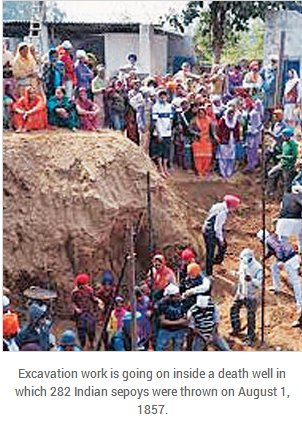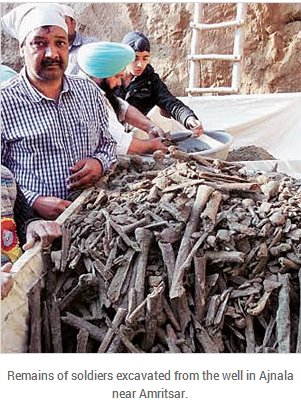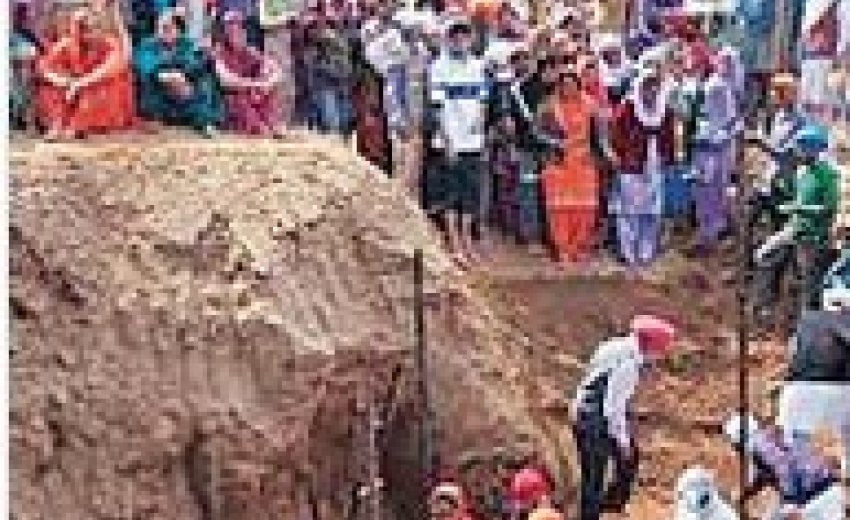 Chandigarh, March 2, 2014: The excavation work at a well in Ajnala near Amritsar, in which 282 Indian soldiers were thrown into on August 1, 1857, on Saturday threw up the remains of around 100 martyrs.
Sikh historian Surinder Kochar and Gurdwara Shaheed Gunj Management Committee have started excavation of the Rebel's Grave, popularly known as the 'kaalon ka kuan', where the Indian soldiers were pushed into by British officials.
Chandigarh, March 2, 2014: The excavation work at a well in Ajnala near Amritsar, in which 282 Indian soldiers were thrown into on August 1, 1857, on Saturday threw up the remains of around 100 martyrs.
Sikh historian Surinder Kochar and Gurdwara Shaheed Gunj Management Committee have started excavation of the Rebel's Grave, popularly known as the 'kaalon ka kuan', where the Indian soldiers were pushed into by British officials.
"The digging of the well continued throughout the day and we found mortal remains of around 100 soldiers, including 50 skulls and 40 jaws, teeth, 47 one rupee coins of the East Indian Company, besides golden jewellery and other goods," Kochar said.
The committee said the excavation work will continue on Sunday to trace remaining mortal remains of 182 human soldiers.
The well used as a mass grave has been covered by a 10-feet layer of soil.
Hundreds of people gathered at the site when the excavation work was started.
There were tears in hundreds of eyes when the committee members found some bones.
The crowd gathered around the site got emotional on seeing the mortal remains of the martyrs after 157 years.
" The whole of Ajanala was crying today.
 Nobody thought about these martyrs for 157 years. They deserve all prayers and will be laid to rest as per faith. We will also be informing the government before the cremation," Gurdwara committee head Amarjit Singh Sarkaria said.
Nobody thought about these martyrs for 157 years. They deserve all prayers and will be laid to rest as per faith. We will also be informing the government before the cremation," Gurdwara committee head Amarjit Singh Sarkaria said.
The August 1, 1857, homicide was perpetrated by Frederick Henry Cooper, the then deputy commissioner of Amritsar, and colonel James George Smith Neill, who was noted for his ruthlessness and indiscriminate killing of Indian rebels and civilians.
Frederick Henry Cooper in his book The Crisis in the Punjab: From the 10th of May Until the Fall of Delhi also mentions this incident as "awful tragedy".
Around 500 Indian soldiers of Regiment 26 of Bengal Native Infantry had fled the Mia Meer Cantonment of Lahore. While 150 soldiers were gunned down, some were swept away in a swollen river. The British army was able to capture 283 sepoys, who were tied with a rope and were brought to Ajnala. According to Cooper, 282 captured soldiers were thrown into the well.
---------------------
Related Article:
To identify martyrs, govt to tie up with British Library
Perneet Singh | Tribune News Servicehttp://www.tribuneindia.com/2014/20140305/punjab.htm#2
Amritsar, March 4: Following the recovery of mortal remains of 1857 uprising martyrs from Kalianwala Khu in Ajnala, the state government has decided to ascertain their identity before performing their last rites.
Senior government officials, including Dr Navjotpal Singh Randhawa, Director, Cultural Affairs, Museums, Archives and Archaeology, and R. Venkataratanam, Divisional Commissioner, today visited the historic site.
Dr Randhawa said: "Ancient coins recovered from the well have made it evident that the mortal remains belong to the soldiers who were a part of the 1857 uprising." He, however, said they would still like to ascertain the identity of all the 282 martyrs for which their department would tie up with British Library to access relevant documents.
On some historians' view about preserving the mortal remains, he said those involved in the excavation were in favour of performing the last rites and their sentiments should be considered while taking any decision in this regard.
Ravi Bhagat, Deputy Commissioner, Amritsar, who also accompanied the officials, said they had already initiated a drive to search for relevant records. "We've started looking for records in the office of the Divisional Commissioner as well as my own office in Amritsar," he said.
On residents' demand to raise a memorial, he said Chief Minister Parkash Singh Badal had already promised the same. The details would be worked out in due course of time, he added.
Surinder Kochhar, a researcher, said the administration had asked them to identify a site for performing the last rites of the martyrs. He said they found another five gold beads from the historic site today.
Meanwhile, the management committee of Gurdwara Shaheed Ganj has exhibited the mortal remains in glass cabins on the gurdwara premises to enable the people to pay respects to the martyrs.
